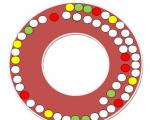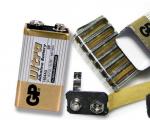All numbers from 1 to 10000. Names of numbers. How compound numbers are formed in English
In the names of Arabic numbers, each digit belongs to its category, and every three digits form a class. Thus, the last digit in a number indicates the number of units in it and is called, accordingly, the place of units. The next, second from the end, digit indicates tens (the tens digit), and the third digit from the end indicates the number of hundreds in the number - the hundreds digit. Further, the digits are repeated in exactly the same way in each class, denoting units, tens and hundreds in the classes of thousands, millions, and so on. If the number is small and does not contain a tens or hundreds digit, it is customary to take them as zero. Classes group numbers in numbers of three, often in computing devices or records a period or space is placed between classes to visually separate them. This is done to make it easier to read large numbers. Each class has its own name: the first three digits are the class of units, followed by the class of thousands, then millions, billions (or billions), and so on.
Since we are using decimal system calculus, then the basic unit of quantity is a dozen, or 10 1. Accordingly, with an increase in the number of digits in a number, the number of tens of 10 2, 10 3, 10 4, etc. also increases. Knowing the number of tens, you can easily determine the class and category of the number, for example, 10 16 is tens of quadrillions, and 3 × 10 16 is three tens of quadrillions. The decomposition of numbers into decimal components occurs as follows - each digit is displayed in a separate term, multiplied by the required coefficient 10 n, where n is the position of the digit in the count from left to right.
For example: 253 981=2×10 6 +5×10 5 +3×10 4 +9×10 3 +8×10 2 +1×10 1
Also, the power of 10 is also used in writing decimals: 10 (-1) is 0.1 or one tenth. Similarly with the previous paragraph, a decimal number can also be decomposed, in which case n will indicate the position of the digit from the comma from right to left, for example: 0.347629= 3x10 (-1) +4x10 (-2) +7x10 (-3) +6x10 (-4) +2x10 (-5) +9x10 (-6) )
Names of decimal numbers. Decimal numbers are read by the last digit of the digits after the decimal point, for example 0.325 - three hundred and twenty-five thousandths, where thousandths are the digit last digit 5 .
Table of names of large numbers, digits and classes
| 1st class unit | 1st unit digit 2nd place ten 3rd rank hundreds |
1 = 10 0 10 = 10 1 100 = 10 2 |
| 2nd class thousand | 1st digit units of thousands 2nd digit tens of thousands 3rd rank hundreds of thousands |
1 000 = 10 3 10 000 = 10 4 100 000 = 10 5 |
| 3rd grade millions | 1st digit units million 2nd digit tens of millions 3rd digit hundreds of millions |
1 000 000 = 10 6 10 000 000 = 10 7 100 000 000 = 10 8 |
| 4th grade billions | 1st digit units billion 2nd digit tens of billions 3rd digit hundreds of billions |
1 000 000 000 = 10 9 10 000 000 000 = 10 10 100 000 000 000 = 10 11 |
| 5th grade trillions | 1st digit trillion units 2nd digit tens of trillions 3rd digit hundred trillion |
1 000 000 000 000 = 10 12 10 000 000 000 000 = 10 13 100 000 000 000 000 = 10 14 |
| 6th grade quadrillions | 1st digit quadrillion units 2nd digit tens of quadrillions 3rd digit tens of quadrillions |
1 000 000 000 000 000 = 10 15 10 000 000 000 000 000 = 10 16 100 000 000 000 000 000 = 10 17 |
| 7th grade quintillions | 1st digit units of quintillions 2nd digit tens of quintillions 3rd rank hundred quintillion |
1 000 000 000 000 000 000 = 10 18 10 000 000 000 000 000 000 = 10 19 100 000 000 000 000 000 000 = 10 20 |
| 8th grade sextillions | 1st digit sextillion units 2nd digit tens of sextillions 3rd rank hundred sextillions |
1 000 000 000 000 000 000 000 = 10 21 10 000 000 000 000 000 000 000 = 10 22 1 00 000 000 000 000 000 000 000 = 10 23 |
| 9th grade septillion | 1st digit units of septillion 2nd digit tens of septillions 3rd rank hundred septillion |
1 000 000 000 000 000 000 000 000 = 10 24 10 000 000 000 000 000 000 000 000 = 10 25 100 000 000 000 000 000 000 000 000 = 10 26 |
| 10th class octillion | 1st digit octillion units 2nd digit ten octillion 3rd rank hundred octillion |
1 000 000 000 000 000 000 000 000 000 = 10 27 10 000 000 000 000 000 000 000 000 000 = 10 28 100 000 000 000 000 000 000 000 000 000 = 10 29 |
The topic of English numbers is quite complicated, since the formation of English numerals is different from the formation of Russian ones. There are rules, but there are exceptions, while both have their own peculiarities. Let's consider English numbers with transcription and Russian pronunciation, point out vivid examples and focus on the exception. Forward for new knowledge!
Numbers in English language are formed differently. Numerals from 1 to 10 have one formation rules, from 13 to 20 - others. Dozens, hundreds and thousands also have features of education.
Features of the formation of numerals from 1 to 12
The table below shows numbers from 1 to 12 with transcription, Russian pronunciation and examples:
| 1 | one | one | |
| 2 | two | [ˈtuː] | that |
| 3 | three | [θriː] | sri |
| 4 | four | for | |
| 5 | five | five | |
| 6 | six | syks | |
| 7 | seven | [ˈsevn̩] | s'even |
| 8 | eight | ate | |
| 9 | nine | nein | |
| 10 | ten | ten | |
| 11 | eleven | [ɪˈlevn̩] | il'even |
| 12 | twelve | tu'elv |
- We wanted one cake, two bananas ang eight apples => We wanted one cake, two bananas and eight apples.
- We need to buy avocado fot this recipe. Or better two ones => For this recipe we need to buy an avocado. Or better two.
- Three kilos of meat, four big tomatoes, five eggplants and garlic will made this evening much more better. I will prepare a very delicious dish by my own recipe! => Three kilos of meat, four large tomatoes, five eggplants and garlic will make the evening much better. I will cook a very tasty dish according to my own recipe!
- Eleven foxes and twelve wolves were seen on this week at this place => Eleven foxes and twelve wolves were seen this week at this place.
Features of the formation of numerals from 13 to 20
| 13 | thirteen | [θɜː'tiːn] | sert'in |
| 14 | fourteen | [ˌfɔː'tiːn] | fort'in |
| 15 | fifteen | [ˌfɪf'tiːn] | fift'in |
| 16 | sixteen | [ˌsɪk'stiːn] | sykstin |
| 17 | seventeen | [ˌsev(ə)n'tiːn] | sevant'in |
| 18 | eighteen | [ˌeɪ'tiːn] | eyth'in |
| 19 | nineteen | [ˌnaɪn'tiːn] | night'in |
The table shows that numbers from 13 to 19 (inclusive) are written according to the same rules, a particle is added to the cardinal number (one, two, three) –teen. And do not confuse cardinal numbers with ordinal numbers! in English they are formed in a completely different way!
On a note! It must be remembered that there are exceptions to every rule. In this case, the exceptions will be the numerals 13 and 15. Their root three and five will have a modified form:
- Three => third
- Five => fifteen.
Not threeteen/fiveteen!!!
Some examples:
- Seventeen girls were seen at this party while only eight boys came. Seventeen girls were seen at the party, while only eight guys showed up.
- Seventeen pieces of cake were given to all those children. All these children were given seventeen pieces of cake.
- There is a lot of fish in this river. Nineteen kinds were known 5 years ago. — There are a lot of fish in this river. Five years ago, nineteen species were known.
Dozens of English numbers
| 20 | twenty | [ˈtwenti] | tu'enty |
| 30 | thirty | [ˈθɜːti] | S'yorti |
| 40 | forty | [ˈfɔːti] | f'orti |
| 50 | fifty | [ˈfɪfti] | f'ifty |
| 60 | sixty | [ˈsɪksti] | s'yksti |
| 70 | seventy | [ˈsevnti] | s'eventi |
| 80 | eighty | [ˈeɪti] | ‘aty |
| 90 | ninety | [ˈnaɪnti] | n'inti |
The table clearly shows that dozens of digits are formed using a particle (suffix) –ty. These numerals are derivatives of cardinal numbers, you just need to add the -ty suffix.
Important! Remember that when forming the numbers 20,30, 40 and 50, the root of the quantitative digits, which serve as the basis for the formation of tens, will change:
- two-20 twenty [ˈtwenti]
- three - 30 thirty [ˈθɜːti]
- four - 40 forty [ˈfɔːti]
- five - 50 fifty [ˈfɪfti]
And one more nuance: the number 80 [ˈeɪti] is characterized by the absence of a repetition of the letter t: eight (eight) = eighty(eight+ty=eightty).
Examples:
- Thirty exotic animals were needed to make the idea of the movie complete => Thirty exotic animals were needed to make the idea of the movie complete.
- Sixty soldiers will come on parade in front of the palace => Sixty soldiers will come to the parade in front of the palace.
- Fifty of them knew the road but only thirty agreed to follow us => Fifty of them knew the road, but only thirty agreed to follow us.
As for the stress of numerals, which are formed with the help of -ty, then everything is simple - stress always will be on the first syllable.
Reference: it happens that it is difficult for novice students to separate numerals with -ty and -teen in colloquial speech. And here the stress will come to the rescue - if it is on the first syllable, then 100% we are dealing with dozens of numerals.
The foundation of the basics: how numbers are formed in English
When studying the formation of English numbers, it is important to remember that the numbers from 1 to 12 are simple cardinal numbers. Their task is to indicate the number of objects. Such numerals consist of one word. It is very important to remember the spelling of the first twelve digits, since they are marching for the formation of all other numbers - from thirteen to a billion.
How to pronounce the numerals that are formed by adding the -teen particle? Here you need to be very careful => the pronunciation of numerals (English digits) will have two stresses: on the first and second syllables. At the same time, we immediately note that the stresses will not be equal in strength. One of them will be secondary, and the other - the main one.
For example, how do you pronounce the word thirteen? The transcription [ˌθɜːˈtiːn] shows that the word has two stresses. The lower line indicates the secondary stress, the upper one - the main one. The same goes for fourteen [ˌfɔːˈtiːn] and fifteen [ˌfɪfˈtiːn]. There are also two accents - the main and additional.
What to do in order not to make a mistake with pronunciation? To do this, you must always look at the transcription. Each numeral, like any other word, should be studied according to the following scheme: transcription - translation - the presence of several meanings.
Note! In some dictionaries, the stress of numerals is determined by the presence (absence) of a noun after it. For example, if the numeral is next to the noun, then the stress falls on the first syllable =>
- fifteen rivers [ˈfɪftiːn ˈrɪvər z]
- sixteen cats [ˈsɪkstiːn ˈkæts]
But! If the numeral stands separately in the sentence, without a noun, then the stress falls on the second syllable (on the suffix -teen):
- fifteen
- sixteen
Examples:
- Fifteen cats were sold this week (emphasis on the first syllable) => Fifteen cats were sold this week
- How many cats were sold this week? – Fifteen (emphasis on the suffix –teen) => How many cats were sold this week? - Fifteen.
| 0 | zero | zero | [‘zɪərəu] | z'irou |
| 1 | one | one | u'an | |
| 2 | two | two | that: | |
| 3 | three | three | [θri:] | sri: |
| 4 | four | four | pho: | |
| 5 | five | five | five | |
| 6 | six | six | sixx | |
| 7 | seven | seven | [‘sevn] | sevn |
| 8 | eight | eight | ate | |
| 9 | nine | nine | nein | |
| 10 | ten | ten | ten | |
| 11 | eleven | eleven | il'evn | |
| 12 | twelve | twelve | TVELV |
Usage examples:
- He knows one girl who can help me. He knows a girl who can help me.
- She has only two options. She has only two options.
- "Seven Psychopaths" is the best movie I have ever seen.- "Seven Psychopaths" - best movie which I happened to watch.
- You need another eight dollars to buy that necklace. “You need eight more dollars to buy that necklace.
- He called me eleven times in six minutes! He called me eleven times in eight minutes!
- My wife paid twelve dollars for a souvenir. My wife paid twelve dollars for a souvenir.
Numbers in English from 13 to 19
The name of the numbers from 13 to 19 in English is quite simple - add the suffix -teen to the unit:
Six (6) + teen = sixteen (16)
Four (4) + teen = fourteen (14)
| 13 | thirteen | thirteen | [θɜː'tiːn] | sho: t'i: n |
| 14 | fourteen | fourteen | fo: t'i: n | |
| 15 | fifteen | fifteen | fifty:n | |
| 16 | sixteen | sixteen | sixty:n | |
| 17 | seventeen | seventeen | sevnt'i:n | |
| 18 | eighteen | eighteen (one t!) | eyt'i:n | |
| 19 | nineteen | nineteen | nint'i:n |
Usage examples:
- Justin Bieber started his career in fourteen . Justin Bieber started his career at the age of fourteen.
- Our journey lasted sixteen days. Our journey lasted sixteen days.
- I wish I could be seventeen forever. “I wish I was always seventeen!”
- She just turned eighteen. She just turned eighteen.
Note:
Sometimes there are small changes in the figure, i.e. just adding the -teen suffix is not enough. In the numbers 13 and 15, another root of the word will be written.
He believes that number thirteen brings bad luck. He believes that the number thirteen brings bad luck.
I spent fifteen days trying to find him in Miami. “I spent fifteen days trying to find him in Miami.
Features of the formation of dozens in English
To get a ten, you need to add the -ty suffix to the unit. Thus: seven (7) + ty = seventy (70).
| 20 | twenty | twenty | [‘twentɪ] | tv'enty |
| 30 | thirty | thirty | [‘θɜːtɪ] | s'yo:ti |
| 40 | Fourty | forty | [‘fɔːtɪ] | f'o:ti |
| 50 | fifty | fifty | [‘fɪftɪ] | f'ifty |
| 60 | sixty | sixty | [‘sɪkstɪ] | s'ixty |
| 70 | seventy | seventy | [‘sev(ə)ntɪ] | s'evnty |
| 80 | eighty | eighty (one t!) | [‘eɪtɪ] | ‘aty |
| 90 | ninety | ninety | [‘naɪntɪ] | n'inti |
Usage examples:
- This mobile costs only sixty dollars. This cell phone costs only sixty dollars.
- My grandmother died at the age of seventy. My grandmother died at the age of seventy.
- I should be there in about eighty minutes. “I should be there in about eighty minutes.
Note:
In some cases, the spelling of tens is changed. The numbers 30 and 50 change in much the same way as the numbers 13 and 15, and at 40 the letter "u" falls out. The number 20 also changes, it looks a bit like 12.
She asked twenty friends to her birthday party. She invited twenty friends to her birthday party.
Anna lost more than thirty kilograms. - Anna lost more than thirty kilograms.
Michael was forty, but he appeared older. Michael was forty, but he looked older.
There are fifty states in the USA. – There are fifty states in the USA.
How are compound numbers formed in English?
Two-digit numbers, as in Russian, are formed by adding one to ten. Please note that when writing between units and tens, you need to add a hyphen.
For example:

Examplesuse:
- Professor Jones has been studying linguistics for forty-five years.“Professor Jones has been studying linguistics for forty-five years.
- Open your books at page fifty nine. Open your books to page fifty-nine.
- Will you still need me when I'm sixty-four?“Will you need me when I turn sixty-four?”
- The man drove the taxi at eighty-seven kilometers an hour. The man was driving a taxi at a speed of eighty-seven kilometers per hour.
- I'm ninety-nine percent sure about it.“I'm ninety-nine percent sure of that.
Numbers in English up to 100: how to pronounce correctly?
If you look at the table, namely the column, which indicates how to pronounce the numbers in Russian, you will notice two features:
- The sign ":" is called long reading. It means that the vowel before this sign must be stretched out in voice. For example, the number two. It should be read as "tu-u", extending the sound "u" a little.
- The second feature is the sign "'", it means accent. , which follows after this character should be emphasized. For example, the number eleven. It must be pronounced "ilEvn", the word should sound with an emphasis on the sound "e".
| 17 | seventeen | seventeen | sevnt'i:n | |
| 18 | eighteen | eighteen (one t!) | eyt'i:n |
Speaking of numbers from 13 to 19, it is important to put the right emphasis here. If you look at the pronunciation table, you can see that the stress in the number always falls on the derived suffix -teen. More importantly, the “and” sound in the suffix should also be extended.
| 40 | Fourty | forty | [‘fɔːtɪ] | f'o:ti |
| 50 | fifty | fifty | [‘fɪftɪ] | f'ifty |
To correctly pronounce tens, it is enough to know the units. The stress falls on the root of the word, as in units. Derivative suffix -ty does not stand out when spoken.
Note:
Especially difficult for English learners is the pronunciation of the letter combination "th", which begins with the numbers 3, 13, 30. The truth is that the sound should not be pronounced as "f" or "s", it is something in between. When pronouncing this sound, the tip of the tongue must be inserted between the teeth. Be sure to listen to how these numbers are pronounced.
What is the difference between a hundred, a thousand, a million and a billion?
| 100 | hundred | one hundred | u'an h'andred | |
| 1.000 | one thousand | one thousand | u'an s'ausend | |
| 1.000.000 | million | one million | u'an m'ilien | |
| 1.000.000.000 | billion | one billion | u'an b'ilien |
Hundreds, thousands, millions and billions can be counted. In order to get such a figure, you need to add a hundred, a thousand, etc. to one. If we are talking about hundreds of millions, the scheme remains the same.
For example:
- Two (2) + one hundred (100)= two hundred (200)
- Seventy-five (75) + one thousand (1.000)= Seventy-five thousand (75.000)
- One hundred (100) + one million (1.000.000)= One hundred million (100.000.000)
- Five hundred (500) + one billion (1.000.000.000)= Five hundred billion (5.000.000.000)
note that in such cases, hundreds, thousands, millions and billions in English do not have a plural ending added. One billion or ten will still be "billion".
Three-digit numbers are formed according to the scheme: one hundred + ten + one.
There is a slight difference in the formation of three-digit numbers between British (Br.E.) and American English (Am.E.). The British put “and” between a hundred and ten, and the Americans do not use this union in three-digit numbers.
For example:
- One hundred (100) + eight (8)= One hundred and eight (Br.E.) or one hundred two (Am.E.) (102)
- Two hundred (200) + forty-three (43)= Two hundred and forty-three (Br.E.) or Two hundred forty-three (Am.E.) (243)
Conclusion
Now we can say with confidence that you know the order of the formation of numbers in English up to 100. To consolidate the study, you can count counting rhymes or listen with the correct pronunciation of numbers in English up to 100.
After several trainings, it will not be difficult for you to learn, be able to write and name any number. We also advise you to perform various exercises or free ones, of which there are many on the Internet, as well as watch video tutorials online.




